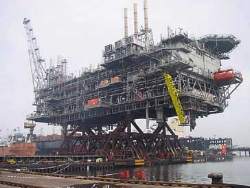What's happening in production
Impressive production topsidesKellogg Brown & Root (KBR), a business unit of Halliburton, completed construction of the Malampaya topsides, a gas-processing facility to be operated by Shell Philippines Exploration BV. The topside facility set sail for offshore Palawan Island in the Philippines, on March 1. At a load-out weight of 11,500 t, the Malampaya topside will be the largest integrated deck ever installed in Asia Pacific. Fabrication of the topside commenced on May 27, 1999, in Singapore and took 21 months to complete. In preparation for transportation, the topside was jacked up 16 m using four jacking columns and 16 sets of strand jacks, each with a capacity of 900 t. A transportation truss weighing 1,500 t was then installed beneath the topsides using eight sets of self propelled bogeys. On February 15, four strand jacks pulled the deck, resting on its transportation truss, 12.4 m along hot-waxed and greased skid beams to the waterfront edge (see picture). The topside was then towed 1,146 nautical mi along the north coast of Borneo to just northwest of Palawan Island, and installed onto a CGS using the float-over method. This method, pioneered by KBR, allows a complete integrated deck to be installed as one unit. The producing facility should be online for gas supply to Philippine power plants by October 1, 2001.
BP’s big gas project. BP’s Nam Con Son basin gas project offshore Viet Nam finally has the nod from all sides. The project will supply gas via pipeline for power generation, which will represent 40% of current demand. The $1.3-billion investment is the largest foreign investment in the country. Two gas fields, Lan Tay and Lan Do, were discovered in 1992 – 93 and have reserves of 2 Tcf. BP is operator with a 27% stake. Its partners are India’s Oil and Natural Gas Corp. (45%), Statoil (13%) and PetroVietnam (15%). Ownership in the pipeline differs somewhat, with PetroVietnam having a 51% share. Winning contractors include: Brown and Root, Hyundai Heavy Industries, Kvaerner Oilfield Products, Coflexip Stena, Llva, European Marine Contractors and McConnell Dowell. Meanwhile, TotalFinaElf began production from Atora field, located in the middle of the Gabonese equatorial forest, about 20 mi north of Gambia. Elf Gabon is operator and holds a 40% interest; its partners are Amerada Hess Gabon (40%) and Shell Gabon (20%). Production should rapidly ramp up to 20,000 bopd. DOE solicits applicants. The goal, scope and background for the DOE program solicitation titled, "Improved Recovery from Low-Permeability Formations" has just been posted at the National Energy Technology Laboratory web site. The comment period will have expired by the time this is printed, but the complete solicitation should be posted by March 30 and will remain open for 45 days. This is a financial assistance / cost-shared cooperative agreement, where the applicant will share a minimum of 20% of the costs. There may be multiple awards, each in the $300,000 to $600,000 range. The work is to be focused on the above-titled topic. Increasing reserves per well with better completion technology, or reducing the completion cost will be some of the work considered. Topics mentioned include: cementing; downhole separation / injection; stimulation techniques; identification of the most productive interval; tubulars (CO2/H2S); multi-laterals; and multiple stimulations from horizontal wells. Work alleviating the cost / amount of high water production will also be awarded. This includes: regional hydrologic studies; water sampling and analysis; new / improved geophysical well log processing; and improved downhole fluid identification. For more information, go to: www.netl.doe.gov. MMS releases EIS on FPSOs. The long-awaited final Environmental Impact Statement from the MMS on FPSOs was released in mid-February. The final document finds that "potential site-specific impacts are essentially the same as with other deepwater development and production systems; that most of the risk is associated with shuttle tankers, not the FPSO itself, and that risk is comparable to the risks from other deepwater systems and from pipelines; and that excluding FPSOs would not reduce cumulative environmental impacts because other systems would be used in its place." Copies of the final report are available at no charge in hard copy or on CD-ROM from the MMS Public Information Office, as well as on the web at www.gomr.mms.gov/homepg/offshore/fpso.html. GTI data book. The Gas Technology Institute (GTI) has published its 2001 edition of its GRI Baseline Projection Data Book. The data book is an extensive projection on North American energy markets and summarizes the statistical foundation used in GRI’s 2001 Baseline Projection, which uses publicly available data as input to GRI’s models. The 800-page, two-volume Data Book has annual data for 1997 through 1999, and a summary of the 2001 Baseline Projection at five-year intervals from 2000 to 2020. The Data Book covers 10 energy categories including supply and demand; energy prices; pipeline data; oil, gas and liquids production; and electricity. More information is available at: www.gri.org.
|
- Applying ultra-deep LWD resistivity technology successfully in a SAGD operation (May 2019)
- Adoption of wireless intelligent completions advances (May 2019)
- Majors double down as takeaway crunch eases (April 2019)
- What’s new in well logging and formation evaluation (April 2019)
- Qualification of a 20,000-psi subsea BOP: A collaborative approach (February 2019)
- ConocoPhillips’ Greg Leveille sees rapid trajectory of technical advancement continuing (February 2019)




